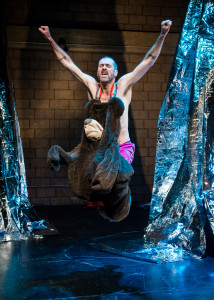ALTHOUGH KEITH HENNESSY’S Bear/Skin, presented at the Omni Commons January 30th and 31st, is a solo piece, the ideas it negotiates are meant to resonate on a community scale.
Bear/Skin sits at an intersection of multiple disciplines, offering the audience glimpses of Hennessy as scholar, anthropologist, poet, set designer, vocalist and dancer. Hennessy begins Bear/Skin with a presentational primer on the ideas at work in his piece. The question he asks through this work is: what is it to make art following a legacy of art based on colonial, cultural appropriation? Rather than providing a singular answer, he offers up his observations on how death has played and continues to play a major role in practices of artistic appropriation and veneration. As well, he observes how death can act as a type of curative, restoring social order to a community.

With these possibilities in mind, Bear/Skin situates Hennessy as the performer, enacting the circumstances of appropriation and artistic re-invention; he speed-reads the gendered and racist Hollywood tropes of every action movie he has seen, he sings his own bear songs, he performs Vaslav Nijinsky’s Rite of Spring choreography of the Chosen One in a bear costume. He also haphazardly recounts other people’s stories of suffering and performs a dance in “fake shaman costume.” When he finishes the piece, he sloughs every trace of costume, pours a libation on it, and then offers the bottle of alcohol to the audience. His initial question still remains, both answered through his performance and still unanswered: how do we make art following a legacy of colonial, cultural appropriation?
What is important about Hennessy’s question and the performance it engenders is how it implies participation. Although Hennessy’s performance offers ways of responding to his question, the fact that his performance never culminate towards an ultimate response shows that he alone is not meant to answer so large a question. And so he invites the audience to participate, saying in his introduction if you (the audience) are uncomfortable being included in the “we” the question evokes, he asks that viewers try it on and approach the discomfort.
The “we” that Hennessy invites to participate speaks to his ethic of community which contextually grounds Bear/Skin’s project. “Community” is a primary interest in Hennessy’s work as well as within the Omni Commons space. Hennessy’s performance group and the presenter of Bear/Skin, Circo Zero, seeks “community through collaboration,” treating performance as “a collective space and public laboratory.” In a similar vein, the Omni Commons space currently works towards being a “free public commons” in which intellectual and creative resources can be shared amongst a growing community. The model of community that both Circo Zero and Omni Commons present is that of a constantly revising “space,” both metaphorical and literal, in which individual participation aids the intellectual and relational evolution of a group of people. As a way of negotiating Hennessy’s question of art in a cultural, colonial legacy, community is not so much an answer as it is a space in which more possibilities for engagement and greater consciousness on the matter at hand can be spread.
Community, as a participatory site for individual and group sharing and growth, is both the grist and the mill in Bear/Skin. Hennessy’s performance offers a vision of community participation that is complicated, inviting the audience to be complicit in his self-sacrifice in the names of appropriation and community ritual. The moment in the performance that best captures the ambiguous participation of the audience in the “we” of Hennessy’s question is when he performs Rite of Spring’s sacrificial dance of the Chosen One inviting a bear costume. Hennessy dances Nijinsky’s choreographed death dance, performing the ritual all the way through to the final pose, his body balanced on his coccyx, legs and torso hovering off the floor. But instead of completing the choreography and releasing all physical tension as a choreographed community rushes onstage to hold up his deceased form, Hennessy remains in this physically tense pose, not yet “dead.”
In this balance, Hennessy is enacting what the audience must cope with: being held fast between the paradoxical pulls of artistic appropriation and veneration. It is apparent that this choreography is now being doubly appropriated; by Hennessy and by the designer and anthropologist, Nicholas Roerich who observed this “pagan dance ritual.” At the same time Hennessy’s entire performance, and this moment in particular, reflect his earlier suggestion that the physical sacrifice and symbolic or real death of an individual can be intended as a community restorative. In this loop of appropriative action and ritualistic self-offering, Hennessy invites the audience into the complicated view of communal growth as based on the mutual extinction, rather than growth, of individuals. In offering such an ambiguous moment to participate in, Hennessy creates the opportunity for the audience to struggle with communal participation as a form of both evolution and complicity.

